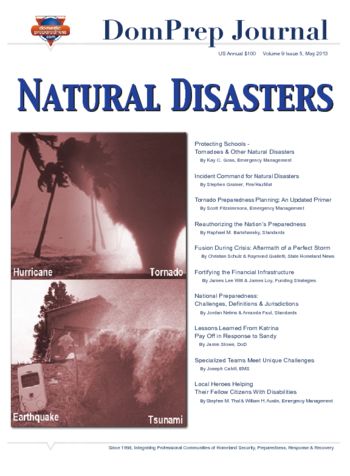

Local Heroes Helping Their Fellow Citizens With Disabilities
Stephen M. Thal and William H. Austin
May 22, 2013
In 2005, the Capitol Region Emergency Planning Committee (CREPC) in Hartford, Connecticut, experienced success in many areas of emergency response preparation. Building on homeland security grants, regional leadership, a common

Lessons Learned From Katrina Pay Off in Response to Sandy
Jamie Stowe
May 22, 2013
From military “takeover” to a “win-win” situation for states affected by natural disasters: The U.S. Department of Defense used the lessons learned from Hurricane Katrina to develop new tactics – and used them creatively when assisting the response and recovery efforts in New Jersey and New York in the wake of Hurricane Sandy.

National Preparedness: Challenges, Definitions & Jurisdictions
Jordan Nelms and Amanda Faul
May 22, 2013
Implementing the guidance provided by Presidential Directive 8 can lead to organizational and procedural challenges – while also working toward greater national preparedness. The first step in implementation is to identify threats and hazards and define the risk as it pertains to a particular jurisdiction. The next step is to determine and validate all potential capabilities currently available.

Incident Command for Natural Disasters: A Natural Fit
Stephen Grainer
May 15, 2013
In February 2003, President George W. Bush signed Homeland Security Presidential Directive Number 5 (HSPD-5), which directed the establishment of a National Incident Management System (NIMS). That directive mandated, among

Fortifying the Financial Infrastructure
James Lee Witt and James M. Loy
May 15, 2013
There is no way to prevent weather disasters from happening, but advance planning, frequent training drills and exercises, and rapid communications can save lives and reduce damage to infrastructure. Under the “Homeowner” bill, that same combination of managerial tools can also be used to reduce the response and recovery costs caused by natural disasters lying in wait.

BIODEFENSE – The Threat, The Cost & The Priority PREVIEW
Stephen Reeves
May 10, 2013
On 22 April 2013, DomesticPreparedness.com hosted an Executive Briefing at The National Press Club in Washington, D.C. Keynote speaker Major General Stephen Reeves, USA (Ret.), started the discussion, and was followed by subject matter experts – each of whom focused on various key components of biodefense – the threats, the costs, and the priorities. These high-level presentations address the scientific, medical, and government policies required to fully comprehend today’s biothreat challenges.

Tornado Preparedness Planning
Scott Fitzsimmons
May 8, 2013
Emergency management is an evolving discipline that requires a progressive emergency manager to
fulfill new and expanding requirements for success. Successful leaders in this field follow a systematic
problem-solving process and excel at coordinating multiple agencies and information sources rather than
simply being experts in one subject. The seven and a half traits discussed here describe the ultimate
emergency manager.

Reauthorizing the Nation’s Preparedness
Raphael M. Barishansky
May 8, 2013
In 2005, Hurricane Katrina ravaged the Gulf Coast of the United States. One of the most important lessons learned from that disaster was that the federal government must work with local authorities to support communities in preparing for, responding to, and recovering from the adverse health effects of major public health emergencies. The Pandemic and All-Hazards Preparedness Act is key to making that possible.

Specialized Teams Meet Unique Challenges
Joseph Cahill
May 1, 2013
People, weather disasters, terrorist attacks, and other criminal activities are inherently unpredictable. Which does not mean that law-enforcement and healthcare agencies cannot prepare for them by using the “special events” calendar as a training curriculum.

Fusion During Crisis: Aftermath of a Perfect Storm
Christian Schulz and Raymond Guidetti
May 1, 2013
In an environment that is constantly changing and increasingly interconnected, many states are finding new ways to use existing assets. In New Jersey, one valuable asset previously used primarily for collecting and analyzing information on terrorist threats played a leading role in the rapid sharing of disaster-response information before, during, and after Hurricane Sandy in late 2012.

